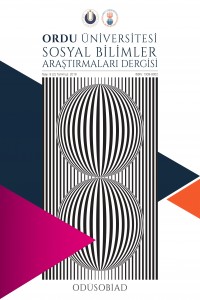Öz
Kaynakça
- Artut, K. (2013), Sanat Eğitimi Kuramları ve Yöntemleri, Ankara: Anı Yayıncılık.Ayık, F. (2004), Çocuksunun Dışavurumcu Resim Sanatındaki Yansımaları ve Sanat Eğitimindeki Önemi, 2. Sanat Eğitimi Sempozyumu, Ankara.Bigalı, Ş. (1984), Resim Sanatı, İstanbul: Türkiye İş Bankası Kültür Yayınları.Buyurgan, S.; Buyurgan, U. (2007), Sanat Eğitimi ve Öğretimi, Ankara: Pegem Yayıncılık.Çankırılı, A. (2014), Çocuk Resimlerinin Dili, İstanbul: Zafer Yayınları.Edgü, F. (1980), Çocuk Resimlerine Doğru Bakalım, İstanbul: Yapı Kredi Bankası Yayınları.Kandinsky, W. (2013), Sanatta Ruhsallık Üzerine, İstanbul: Altıkırkbeş Yayınları.Kehnemuyi, Z. (2013), Çocuğun Görsel Sanat Eğitimi, İstanbul: Yapı Kredi Yayınları.Yavuzer, H. (2011), Resimleriyle Çocuk, İstanbul: Remzi Kitabevi.
Öz
Picture
is a communication tool that reveals a person's inner world of thoughts, the
mental and physical development. The pictorial feature of the child begins with
the first scribbling stage and shows the development in parallel with the
growth. When we look at all this development, they show with stains, shapes and
vague lines that gains resulting painting in intellectual and artistic sense.
Children express us their concept perception, reaction, skill, feeling and thoughts
in a powerful way than words with pictures. Moreover, these are made without
planning from advance. Each child differently interpretations their sense and
transfer their pictures its own line, symbols and signs.
Children
offer us a rich narrative by expressing themselves with simple, pure and direct
lines. This study seeks to analyze the lines, charts, figures and colors used
by the children in pre-schematic period (4-7 years) in their pictures from
artistic viewpoint. By taking quantity of exposition and characteristic
features of the pictures of children into consideration, it is thought to give
a new perspective to these values and in this regard it was aimed to create
unique compositions on ceramic surfaces. Works will be prepared by using white
casting clay and glazes in various colors, in search of different sizes and
shapes. Ceramic works will be treated in two groups as relief panels and
sculpture.
This
study that aimed at ceramic surface interpretation of children's drawings will
include information on the pictures and historical development of children,
child development stages of the painting, drawing features, use of color and
creativity. Research will focus on figures in their children's paintings.
However, collected theoretical and visual documents will be expressed in a new
perspective blended with personal experiences. Works that place of
relationships pictures and ceramic art is intended to give a new dimension to
contemporary ceramic art by creating a rich visual language of plastic.
The
common deduction that can be made by evaluating the aesthetics of the works; it
is intended to protect the natural color of the clay on the surfaces and to refer
to the pure and simple narration of the child. The figures, shapes and
movements used on the surfaces were glazed in vivid colors and created
different tone effects. In this way, the depth and contrast of the work that
has been introduced to the work have added visual vitality by adding excitement
and rhythm sensation to the work. It is aimed at ensuring the integrity and
continuity between the works during the exhibition. The images of the children
were assessed in the direction of their own proficiency and, while the works
were being created, the technical and extensive narration facilities of the art
of ceramics were utilized. It is aimed to give a new interpretation with
childlike, witty, simple and simple style with a visual plastic language and to
shed light on contemporary ceramic art.
Anahtar Kelimeler
Kaynakça
- Artut, K. (2013), Sanat Eğitimi Kuramları ve Yöntemleri, Ankara: Anı Yayıncılık.Ayık, F. (2004), Çocuksunun Dışavurumcu Resim Sanatındaki Yansımaları ve Sanat Eğitimindeki Önemi, 2. Sanat Eğitimi Sempozyumu, Ankara.Bigalı, Ş. (1984), Resim Sanatı, İstanbul: Türkiye İş Bankası Kültür Yayınları.Buyurgan, S.; Buyurgan, U. (2007), Sanat Eğitimi ve Öğretimi, Ankara: Pegem Yayıncılık.Çankırılı, A. (2014), Çocuk Resimlerinin Dili, İstanbul: Zafer Yayınları.Edgü, F. (1980), Çocuk Resimlerine Doğru Bakalım, İstanbul: Yapı Kredi Bankası Yayınları.Kandinsky, W. (2013), Sanatta Ruhsallık Üzerine, İstanbul: Altıkırkbeş Yayınları.Kehnemuyi, Z. (2013), Çocuğun Görsel Sanat Eğitimi, İstanbul: Yapı Kredi Yayınları.Yavuzer, H. (2011), Resimleriyle Çocuk, İstanbul: Remzi Kitabevi.
Ayrıntılar
| Birincil Dil | Türkçe |
|---|---|
| Bölüm | MAKALE |
| Yazarlar | |
| Yayımlanma Tarihi | 27 Temmuz 2018 |
| Gönderilme Tarihi | 8 Mayıs 2018 |
| Yayımlandığı Sayı | Yıl 2018 Cilt: 8 Sayı: 2 |
Bilginin ışığında aydınlanmak dileğiyle....
ODÜSOBİAD


